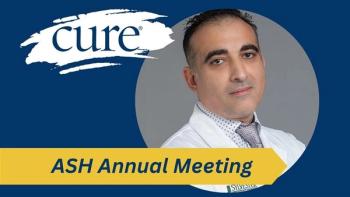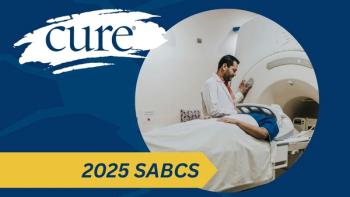
Addressing Complications from ADT Therapy to Treat Prostate Cancer

Key Takeaways
- ADT reduces testosterone, crucial for prostate cancer cell growth, but causes side effects impacting quality of life.
- Cardiovascular risks, insulin resistance, and bone density loss are significant concerns for patients on ADT.
Dr. Alicia Morgans discussed complications associated with ADT in prostate cancer, and how men can still maintain quality of life regardless.
Androgen deprivation therapy (ADT), often referred to as hormonal therapy, is effective in slowing cancer growth among men with prostate cancer; however, maintaining quality of life in tandem with its side effects is important.
ADT works by significantly lowering testosterone levels, a hormone vital for prostate cancer cell growth. “It is essentially the food or the fuel that drives those cells to do the things that they want to do, which in this case, is something we don't want them to do: to replicate or to grow,” explained Dr. Alicia Morgans. However, she added that this intentional reduction can lead to a range of side effects impacting overall well-being among patients with prostate cancer.
At the CURE Educated Patient Prostate Cancer Summit, Morgans, a genitourinary medical oncologist and the director of the Survivorship Program at Dana-Farber Cancer Institute, shed light on these potential complications and offered strategies to maintain a high quality of life during and after treatment with ADT.
ADT’s Impact on Hormone Levels
Morgans explained that ADTs work by disrupting the body's natural testosterone production by targeting the pituitary gland in the brain, which normally stimulates the testes to produce testosterone.
“These drugs that we use are (gonadotropin-releasing hormone, or GnRH) agonists or antagonists ¾ GnRH being a receptor that's on the pituitary gland that normally is stimulated by other parts of the brain and the hypothalamus to cause this testosterone production, but when we act on those receptors with these medicines, we cause all kinds of feedback loops that ultimately cause the testes to stop producing testosterone, and that testosterone level goes down very, very low,” she said.
However, in addition to reductions in testosterone levels, a secondary effect of ADT occurs on men’s estrogen levels. “These estrogen levels are lower than that that we see in postmenopausal women, and that combination of low hormone levels is what explains a lot of the symptom burden that we see when we use androgen deprivation therapy and see the complications that we do,” Morgans added.
Cardiovascular Risk in Prostate Cancer
The impact of ADT extends to various bodily systems; therefore, patients need to understand these potential medical complications to manage them effectively with their care teams.
Because heart disease is a leading cause of death in the US, patients should be aware of their risk for cardiovascular disease, regardless of cancer status, according to Morgans. “This heart risk and cancer risk of mortality are competing throughout somebody's life. So it's really important that we emphasize an interest in and an understanding of heart disease and ways that we can reduce the risk of complications from heart disease.”
In regard to treatment with ADTs, low testosterone levels may contribute to factors that increase cardiovascular risk, such as increased total cholesterol, increased triglycerides, increased abdominal adipose tissue, impaired glucose metabolism or weight gain.
Particularly, one study evaluated 100 consecutive patients with prostate cancer who were going to a urology clinic. The common coronary artery disease risk factors seen were hypertension (58%), dyslipidemia (high cholesterol; 51%) and diabetes (17%). Further, 17% reported coronary artery disease, of which nine had a history of stents and five had bypass surgery on their heart.
Out of 100 patients, only four had no cardiac risk factors. “Most people are going to have some risk factors, and we need to do something to prevent progression of those risk factors into disease,” Morgans said, adding that a history of heart disease increases the risk of heart complications in patients being treated with ADT.
Additional Health Complications
In addition to cardiovascular risk, treatment with ADT is also associated with insulin resistance.
In a retrospective cohort study, researchers found that patients with prostate cancer demonstrated a 36% higher risk of being diagnosed with diabetes 12 months after initiating treatment with ADT (1,231 patients), compared with patients who had not received this type of treatment (7,250 patients). Morgans explained that this is because treatment with ADT can lead to insulin resistance, meaning a patient’s body needs more insulin to keep blood sugar levels stable.
In addition, Low testosterone and low estrogen levels due to treatment with ADT can negatively impact bone density. Morgans explained that bones are constantly undergoing a process of remodeling, with old bone being reabsorbed and new bone being formed. Therefore, during treatment with ADT, bone breakdown outpaces formation, leading to a loss of bone density, in turn, increasing the risk of osteoporosis (thin, brittle bones) and fractures.
“And if we do see someone who develops a fracture, particularly a hip fracture, this can cause loss of mobility, loss of independence and has financial implications when people can't work and can't take care of themselves, so we absolutely try to prevent this and make sure that it's not a problem for people,” she said.
Being Proactive in Prostate Cancer Care
Morgans highlighted guidelines and a systemic approach to the A, B, C, D, Es of being proactive about some of these complications, which included:
- Awareness: Patients should be informed about the potential cardiovascular risks associated with ADT.
- Blood Pressure: Patients should regularly monitor and manage blood pressure.
- Cholesterol and Cigarettes: Patients should monitor and manage cholesterol levels, and if they smoke, quitting is paramount.
- Diet/Weight Management and Diabetes: Patients should adopt a heart-healthy diet, such as the Mediterranean diet, which is low in saturated fats and red meat, and focus on weight management. If a patient has diabetes, they should diligently manage their blood sugar.
- Exercise: Patients should engage in regular physical activity.
Further, to address issues with bone density, Morgans recommended that patients take 1,000 to 1,200 milligrams of calcium and 400 to 1,000 units of vitamin D daily, participate in weight-bearing exercises like walking, and talk to their doctors if there would be benefit from medications that help strengthen bones.
Psychosocial Complications
Depression is a common, yet often underdiagnosed, condition in the general population, and can affect a vast majority of patients with cancer. Morgans discussed a study that showed among more than 78,000 men with prostate cancer, of the 43% being treated with ADT, their risk for depression increased by 23%.
“We … need to think about depression and think about cognitive change and ask about it in clinic visits … (and) screen for things like depression,” she said. “…These general screening tools can be really helpful to identify depression, and we have multiple treatments that we can use to treat depression: medicines, counseling, even support groups can be helpful, and exercise can be helpful here.”
In addition, cognitive complications, such as learning and memory, can arise as a result of low testosterone. Morgans explained that testosterone crosses the blood-brain barrier and acts in learning and memory, having a protective effect in preventing cognitive declines. Therefore, lower levels of testosterone can be associated with poorer visual and verbal memory.
“When it comes to cognitive change, we also rely on these general screening tools, and we sometimes refer people to a geriatrician or to a neurologist for an evaluation,” she said. “We can all work together to make these diagnoses with family members, and we can use primary care doctors, psychologists, psychiatrists to help us treat these disorders as well.”
Sexual Health
Sexual dysfunction is a common concern among men with prostate cancer, stemming from various factors including nerve issues from surgery or radiation, psychological distress related to cancer and the loss of libido, or sex drive, and interest in sex caused by treatment with ADT.
“It's really important that, if it is something important to patients or to an individual patient or a couple, that they talk about it with their doctor and think about ways to potentially improve things,” Morgans said, adding that there are medications that can be used, as well as a vacuum erection device or penile prosthesis, as well as other ways of sharing intimacy for counseling services available to aid with sexual dysfunction.
“Patients with prostate cancer who are living with or after hormonal treatment are at risk for multiple challenges, multiple complications, including things that affect heart, bones, muscles, blood sugar, mood and other systems. But there are ways that we can identify these challenges and prevent or reverse the effects,” Morgans concluded. “Through exercise, healthy diet, working with primary care, making the diagnosis is the first step, and talking with loved ones about what you need and what they need can be critical, and again, making life better during or after ADT.”
For more news on cancer updates, research and education,





